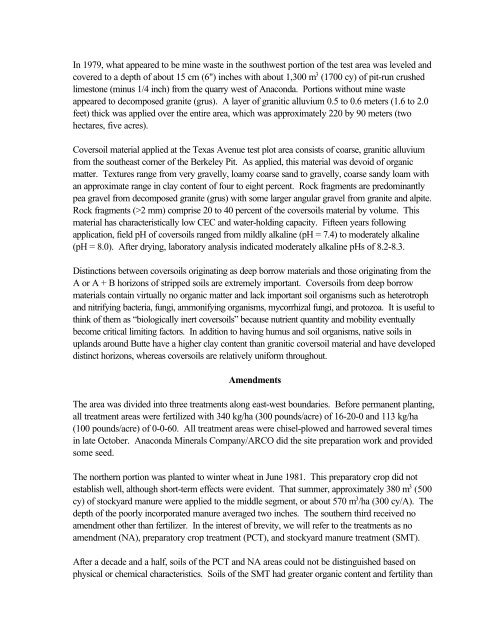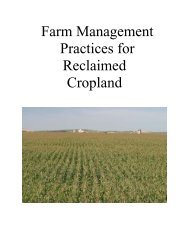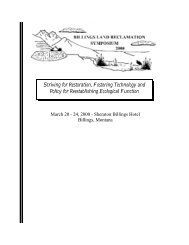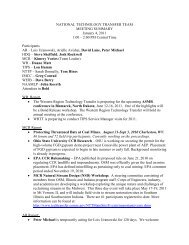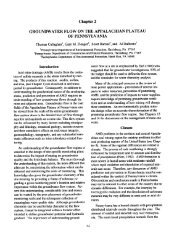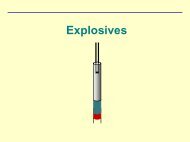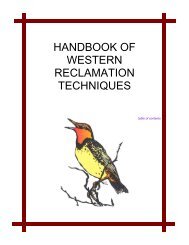Revegetation - OSM Technology Transfer - Office of Surface Mining
Revegetation - OSM Technology Transfer - Office of Surface Mining
Revegetation - OSM Technology Transfer - Office of Surface Mining
Create successful ePaper yourself
Turn your PDF publications into a flip-book with our unique Google optimized e-Paper software.
In 1979, what appeared to be mine waste in the southwest portion <strong>of</strong> the test area was leveled and<br />
covered to a depth <strong>of</strong> about 15 cm (6") inches with about 1,300 m 3 (1700 cy) <strong>of</strong> pit-run crushed<br />
limestone (minus 1/4 inch) from the quarry west <strong>of</strong> Anaconda. Portions without mine waste<br />
appeared to decomposed granite (grus). A layer <strong>of</strong> granitic alluvium 0.5 to 0.6 meters (1.6 to 2.0<br />
feet) thick was applied over the entire area, which was approximately 220 by 90 meters (two<br />
hectares, five acres).<br />
Coversoil material applied at the Texas Avenue test plot area consists <strong>of</strong> coarse, granitic alluvium<br />
from the southeast corner <strong>of</strong> the Berkeley Pit. As applied, this material was devoid <strong>of</strong> organic<br />
matter. Textures range from very gravelly, loamy coarse sand to gravelly, coarse sandy loam with<br />
an approximate range in clay content <strong>of</strong> four to eight percent. Rock fragments are predominantly<br />
pea gravel from decomposed granite (grus) with some larger angular gravel from granite and alpite.<br />
Rock fragments (>2 mm) comprise 20 to 40 percent <strong>of</strong> the coversoils material by volume. This<br />
material has characteristically low CEC and water-holding capacity. Fifteen years following<br />
application, field pH <strong>of</strong> coversoils ranged from mildly alkaline (pH = 7.4) to moderately alkaline<br />
(pH = 8.0). After drying, laboratory analysis indicated moderately alkaline pHs <strong>of</strong> 8.2-8.3.<br />
Distinctions between coversoils originating as deep borrow materials and those originating from the<br />
A or A + B horizons <strong>of</strong> stripped soils are extremely important. Coversoils from deep borrow<br />
materials contain virtually no organic matter and lack important soil organisms such as heterotroph<br />
and nitrifying bacteria, fungi, ammonifying organisms, mycorrhizal fungi, and protozoa. It is useful to<br />
think <strong>of</strong> them as “biologically inert coversoils” because nutrient quantity and mobility eventually<br />
become critical limiting factors. In addition to having humus and soil organisms, native soils in<br />
uplands around Butte have a higher clay content than granitic coversoil material and have developed<br />
distinct horizons, whereas coversoils are relatively uniform throughout.<br />
Amendments<br />
The area was divided into three treatments along east-west boundaries. Before permanent planting,<br />
all treatment areas were fertilized with 340 kg/ha (300 pounds/acre) <strong>of</strong> 16-20-0 and 113 kg/ha<br />
(100 pounds/acre) <strong>of</strong> 0-0-60. All treatment areas were chisel-plowed and harrowed several times<br />
in late October. Anaconda Minerals Company/ARCO did the site preparation work and provided<br />
some seed.<br />
The northern portion was planted to winter wheat in June 1981. This preparatory crop did not<br />
establish well, although short-term effects were evident. That summer, approximately 380 m 3 (500<br />
cy) <strong>of</strong> stockyard manure were applied to the middle segment, or about 570 m 3 /ha (300 cy/A). The<br />
depth <strong>of</strong> the poorly incorporated manure averaged two inches. The southern third received no<br />
amendment other than fertilizer. In the interest <strong>of</strong> brevity, we will refer to the treatments as no<br />
amendment (NA), preparatory crop treatment (PCT), and stockyard manure treatment (SMT).<br />
After a decade and a half, soils <strong>of</strong> the PCT and NA areas could not be distinguished based on<br />
physical or chemical characteristics. Soils <strong>of</strong> the SMT had greater organic content and fertility than


